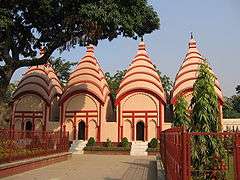Old Dhaka
Old Dhaka (in Bengali, পুরান ঢাকা ) is a term used to refer to the historic old city of Dhaka, the capital of modern Bangladesh.[1] It was founded in 1608 as Jahangir Nagar, the capital of Mughal Bengal. It was one of the largest and most prosperous cities of South Asia and the center of the worldwide muslin trade. The Nawab of Bengal shifted the capital from Dhaka to Murshidabad in the early-18th century. With the rise of Calcutta (now Kolkata) during the British rule, Dhaka began to decline and came to be known as the "City of Magnificent Ruins". The British however began to develop the modern city from the mid-19th century.[2]

Old Dhaka is famous for its variety of foods and amicable living of all religion people together. The main Muslims festival here is Eid-ul-Fitr, Eid-ul-Adha and Muharram, Hindu festivals are Durga Puja, Kali Puja, Saraswati Puja, Holi, Rathyatra and Janmashtami, Christian festival Christmas and Easter Sunday, and Buddhist Festival is Vesak. The all religion festival here is "Shakrain"(পৌষ সংক্রান্তি)and "Halkhata"(হালখাতা) with much splendor and devotion in this part of Dhaka.Muslims are main population here, second Hindu,third Christian and Buddhist.
History


The existence of a settlement in the area that is now Dhaka dates from the 7th century. The city area was ruled by the Buddhist kingdom of Kamarupa and the Pala Empire before passing to the control of the Hindu Sena dynasty in the 9th century. The name of the town may have derived after the establishment of the Goddess Dhakeshvari's temple by Ballal Sena in the 12th century.
After the Sena Empire, Dhaka was successively ruled by the Sultanate of Bengal as well as interruption of governors from the Delhi Sultanate before being taken over by the Mughals in 1608. The development of townships and housing has resulted in a significant growth in population came as the city was proclaimed the capital (Rajmahal) of Subah Bangalah under Mughal rule in 1608. Mughal Subahdar Islam Khan was the first administrator of the city. Khan named the town "Jahangir Nagar" (জাহাঙ্গীর নগর; City of Jahangir) in honour of the Mughal Emperor Jahangir, although this name was dropped soon after Jahangir's death.
.jpg)
Neighborhoods
- Chowk Bazaar
- Shankhari Bazaar
- Lakshmibazar
- Banglabazar
- Sutrapur
- Jaluanagar
- Banianagar
- Goalnagar
- Tantibazar
- Sutarnagar
- Kamarnagar
- Patuatuli
- Armanitolla
- Sadarghat
- Bangsal road
- Babubazaar
- Wari
- Begumbazaar
- Lalbagh
- Kotwali
- Dholaikhal
- Kaltabazar
- Gandaria
Administration
Old Dhaka consists of 8 metropolitan thanas- Hazaribagh, Lalbagh, Chowkbazar, Bangsal, Kotwali (Dhaka Sadar), Wari, Sutrapur and Gendaria. Old Dhaka is under the administration of Dhaka South City Corporation. Old Dhaka is bounded by the areas of Mohammadpur on the west, Dhanmondi, New Market, Shahbagh, Ramna, Motijheel and Sabujbagh on the north, Jatrabari and Shyampur on the east, adding also Kamrangir Char Thana and Keraniganj Upazila on the south.
Landmarks
List of landmarks in this region:
- Northbrook Hall (Lalkuthi)
- Lalbagh Fort
- Chowk Bazaar Shai Mosque
- Dhakeshwari Temple
- Hussaini Dalan
- Armenian Church
- Tara mosque
- Ahsan Manzil
- Bara Katra
- Choto Katra
Local customs and food
Local famous foods are :
- Haji Biriyani
- Bakarkhani
- Beauty Lachchi
- Royel Nehari
- Nawab Kachchi
 Traditional Iftaari of Chowkbazar
Traditional Iftaari of Chowkbazar Sheek Kebab
Sheek Kebab Bakarkhani
Bakarkhani- Pohela Boishakh in Bahadur Shah Park
 Shakrain (Poush Sangkranti)
Shakrain (Poush Sangkranti) Traditional TomTom
Traditional TomTom
See also
External links
-
 Old Dhaka travel guide from Wikivoyage
Old Dhaka travel guide from Wikivoyage - Dhaka City
References
- ↑ Chowdhury, AM (2012). "Dhaka". In Islam, Sirajul; Jamal, Ahmed A. Banglapedia: National Encyclopedia of Bangladesh (Second ed.). Asiatic Society of Bangladesh.
- ↑ http://www.bbc.com/travel/feature/20110815-saving-dhakas-heritage